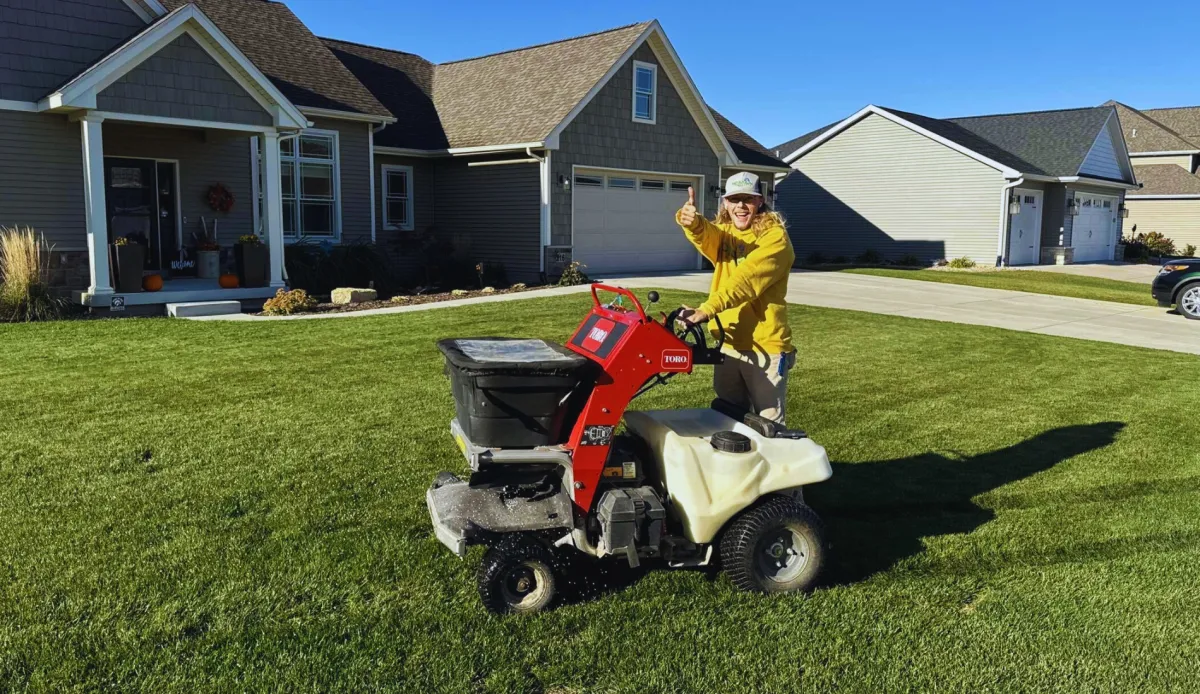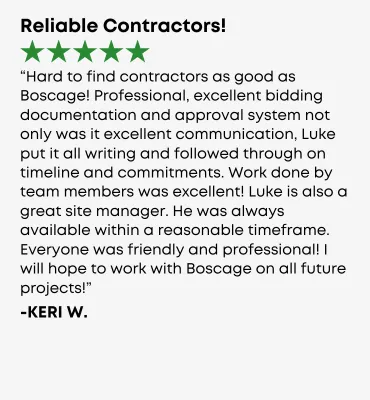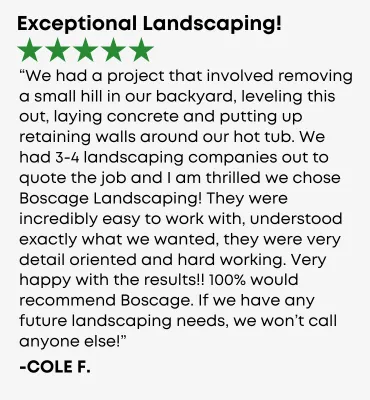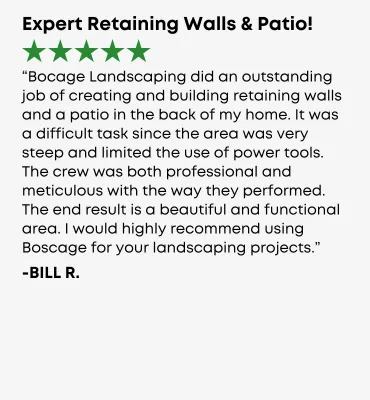
Spring is Here | 10 Essential Spring Lawn Care Tips for Bettendorf Homeowners
Spring is finally showing its face in the Quad Cities, and that means it's time to get your lawn ready! In short, it’s Bettendorf lawn care season!
Here in Bettendorf, we face unique challenges with our Iowa climate - from unpredictable spring rainfall to our heavy clay soils that drain poorly. As a locally owned landscaping company with deep roots in this community since 2014, we've learned exactly what works for lawns in our area. I'm Luke Franich, owner of Boscage Landscaping, and I want to share some essential spring lawn care tips that will help your yard thrive this season.
I've pulled together these recommendations based on what we've found works best specifically for Bettendorf and Quad Cities lawns over our 25+ years of combined experience. A big shoutout to Brian at Turf Mechanic for creating a great video on the topic. I’ve summarized some points specific to our Davenport lawn care challenges.
1. Clear Away Winter Debris
Before you can do anything meaningful with your lawn, you need to start with a clean slate. In Bettendorf, our winters can leave behind a mess of branches, leaves, and debris. This layer of material prevents sunlight from reaching your grass and creates the perfect environment for lawn diseases that thrive in our humid summers.
At Boscage, we've found that a thorough spring cleanup is the foundation for everything that follows. Our team uses professional-grade equipment to remove all debris without damaging the emerging grass beneath. This simple first step allows your lawn to breathe and prepares it for the treatments to come.
2. Dethatch When Soil Temperatures Rise
Unlike other parts of the country, our Bettendorf lawns tend to accumulate thatch more quickly due to our heavy clay soils. Once soil temperatures consistently reach 50°F (usually by mid-April in our area), it's time to dethatch.
Dethatching removes the layer of dead grass that sits between the soil surface and the living grass. In the Quad Cities, this step is crucial because thatch prevents water from penetrating our already poorly-draining clay soils. Our clients are often shocked at how much dead material comes up during this process!
We use professional power rakes that are specifically calibrated for cool-season grasses common in the Midwest. If you're doing this yourself, be careful not to set the tines too deep – you want to remove the thatch without damaging the living grass beneath.
3. Aerate to Combat Our Clay Soils
If there's one thing most Bettendorf homeowners struggle with, it's our dense, compacted clay soils. Core aeration is absolutely essential in our region, much more so than in areas with sandier soil compositions.
After servicing over 500 active clients throughout the Quad Cities, we've found that spring aeration makes an enormous difference in lawn health throughout the entire growing season. Aeration creates channels for water, air, and nutrients to penetrate deep into the root zone.
The key difference in our approach? We time our aeration based on soil temperature rather than the calendar. In Bettendorf, we typically hit the ideal window in late April, but this can shift based on the specific weather patterns each year. Our team monitors soil conditions closely to ensure we're aerating at precisely the right time.
4. Top Dress with Local Compost Materials
After aeration, we recommend top dressing with quality organic materials. Here's where our local approach really differs: we've developed relationships with local suppliers to source premium compost materials that are specifically matched to the soil profile in the Quad Cities region.
For Bettendorf lawns, we've found that a custom blend of composted leaf mold and earthworm castings works exceptionally well. This mixture helps to gradually amend our clay soils, improving drainage while adding essential micronutrients.
A thin layer – about 1/4 inch – spread evenly across the lawn will work its way into the aeration holes and begin the soil improvement process. This step is especially important for properties in newer developments where topsoil may have been removed during construction – something we see frequently in growing areas like LeClaire and northern Bettendorf.
5. Apply Specialized Soil Amendments for Midwest Lawns
This is where our approach really sets us apart. Based on our extensive experience with Quad Cities soil conditions, we apply a specialized blend of mycorrhizae and humic acid that's calibrated for our local soil pH.
The typical soil pH in Bettendorf ranges from 6.2 to 7.1, and our custom blend is formulated to work optimally within this range. These biological amendments create a healthier soil ecosystem that supports stronger root development – crucial for helping your lawn survive both our humid summers and harsh winters.
After applying these amendments to hundreds of Bettendorf lawns, we've documented significantly improved drought resistance and reduced disease pressure throughout the summer months.
6. Time Your Pre-Emergent and Fertilizer Application Precisely
Timing is everything when it comes to pre-emergent herbicide application in our area. The challenge in Bettendorf is that our spring temperatures can fluctuate wildly, making it difficult to time applications correctly.
Based on our decade of experience, we've found that soil temperature is a much more reliable indicator than the calendar. For Bettendorf lawns, we typically apply pre-emergent when soil temperatures consistently reach 55°F at a 2-inch depth – usually around the last week of April, though this can vary by up to two weeks depending on the year.
We pair this with a slow-release fertilizer specially formulated for our cool-season grasses and higher clay content soils. The fertilizer we use has a higher percentage of slow-release nitrogen than what's typically recommended for other regions, which provides more consistent feeding throughout our sometimes unpredictable spring weather patterns.
7. Implement Efficient Watering Strategies for Iowa's Climate
After applying pre-emergent and fertilizer, proper watering is crucial. In Bettendorf, our spring rainfall patterns can be unpredictable – sometimes we get too much rain, sometimes not enough.
We recommend setting up a smart irrigation system that can adjust based on actual weather conditions. For our clients, we often install rain sensors that automatically prevent unnecessary watering after significant rainfall – something that's becoming increasingly important as we experience more erratic weather patterns.
The key for Bettendorf lawns is deep, infrequent watering rather than frequent shallow watering. This encourages deeper root growth, which is essential for surviving our hot summer months when drought conditions can develop quickly.
8. Maintain Proper Mowing Heights for Midwest Grasses
Most Bettendorf lawns are predominantly cool-season grasses like Kentucky bluegrass, perennial ryegrass, and fescue blends. These grasses require different mowing heights than warm-season varieties found further south.
In spring, we recommend maintaining a mowing height of 2.5-3 inches, gradually increasing to 3.5-4 inches as temperatures rise into summer. This higher cutting height helps shade the soil, reduces weed pressure, and improves drought tolerance – all critical factors for Quad Cities lawns.
Remember that the one-third rule is especially important in our region – never remove more than one-third of the grass blade in a single mowing. During peak growing season in late spring, this might mean mowing twice weekly for optimal lawn health.
9. Apply Moisture Management Products for Summer Preparation
By late spring (usually mid-May in Bettendorf), we recommend applying a moisture management product like Hydretain. This step is particularly important in our region because we often experience periods of drought in July and August.
These products work differently from traditional wetting agents by reducing evaporation at the root zone. We've documented up to 50% reduction in watering needs for our clients who incorporate this step into their lawn care program – a significant benefit during water conservation periods.
10. Implement Preventative Grub Control for Quad Cities Pest Pressure
May is the perfect time to apply preventative grub control in our area. We've found that Bettendorf and the surrounding Quad Cities have specific Japanese beetle pressure zones, particularly in neighborhoods with mature trees and established landscapes.
After treating hundreds of lawns throughout the region, we've developed a targeted approach based on historical pest pressure data. We use lower-impact prevention methods in areas with less history of damage, and more intensive treatments in known hotspots. This tailored approach provides effective protection while minimizing environmental impact.
Your Lawn Deserves Local Expertise
While these tips provide a solid foundation for spring lawn care in Bettendorf, every property has its own microclimate and specific needs. Our team at Boscage Landscaping brings over 25 years of combined experience working specifically with Quad Cities lawns.
The difference shows in our results – over 500 active clients choose us for their lawn and landscaping needs, with a 4.8-star rating across more than 50 reviews. We understand the unique challenges of Iowa lawns because we've been transforming them for over a decade.
Whether you're looking to tackle these steps yourself or would prefer to have our professional team handle your lawn care needs, we're here to help. We offer custom lawn care packages designed specifically for Bettendorf properties and can provide a detailed assessment of your lawn's specific needs.
Contact us today for a fast estimate (typically within 24 hours) and discover why your neighbors choose Boscage Landscaping for their lawn and landscape needs. Call us at (563) 555-1234 or visit www.boscagelandscaping.com to request a quote.






